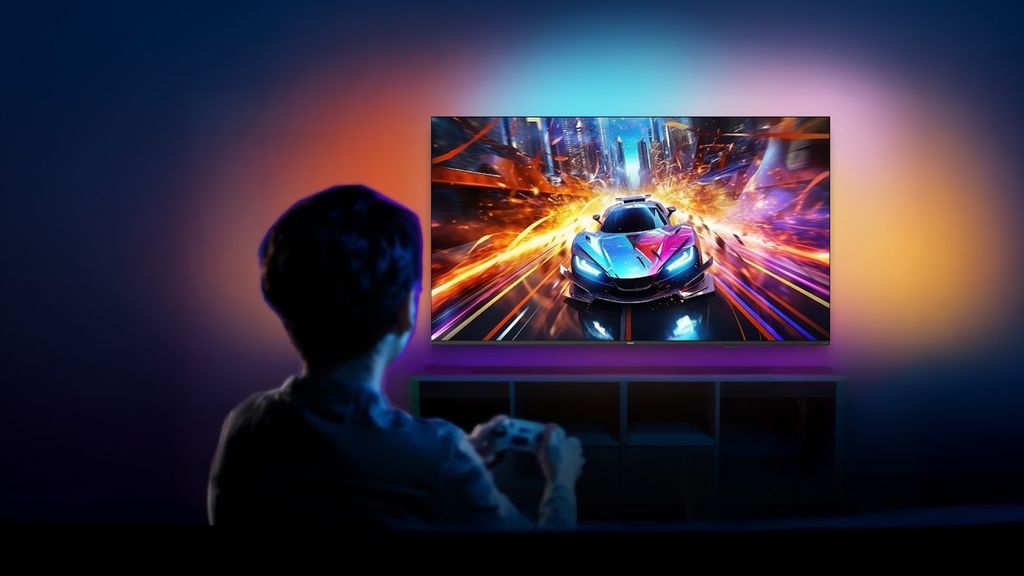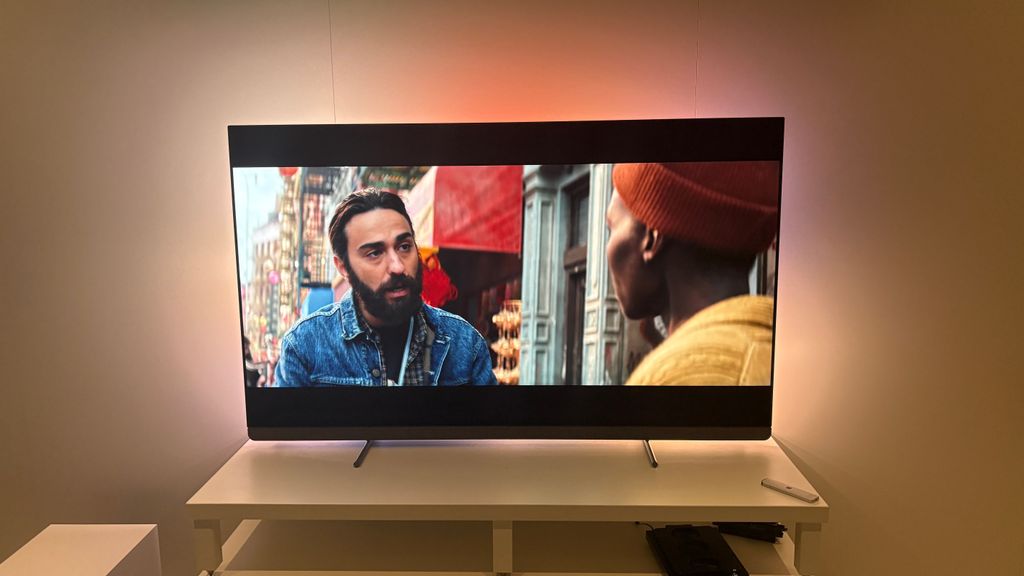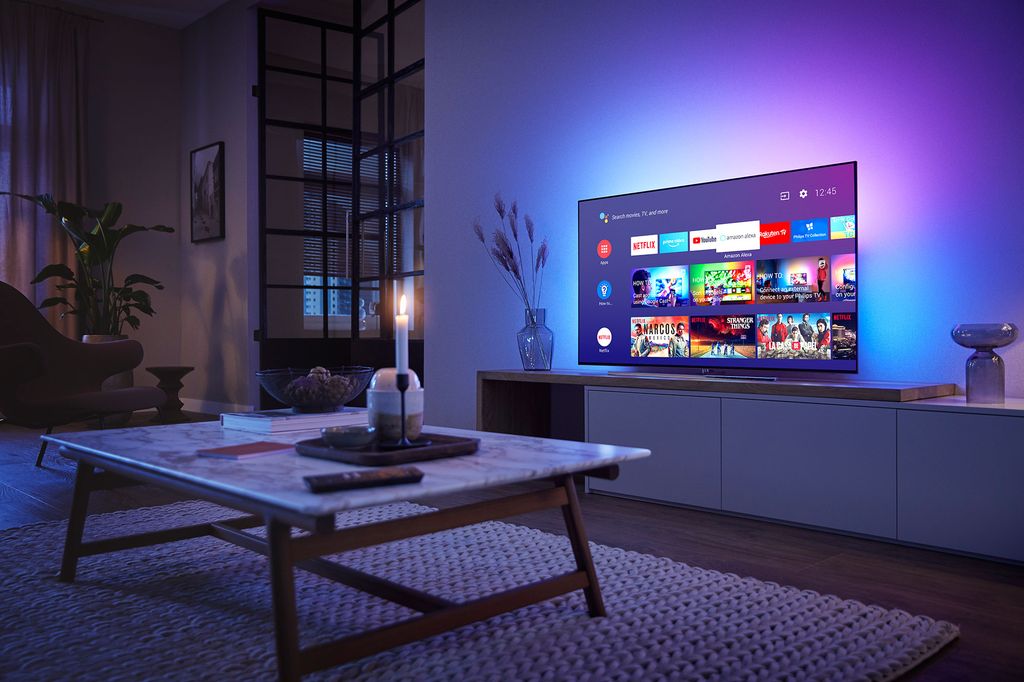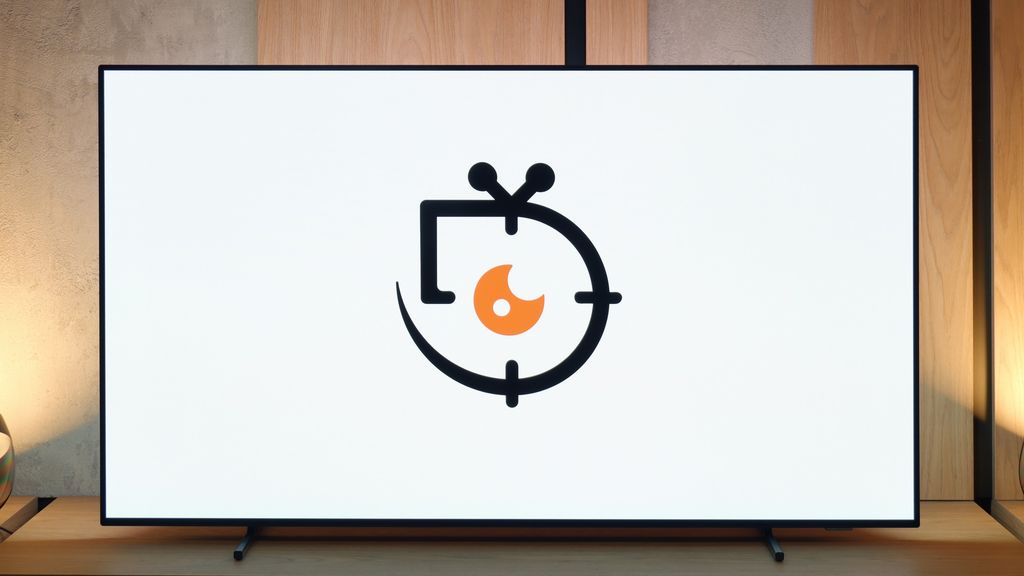- Matching (Score)
- Our verdict
- Competing TVs
- TV appearance
- Where to buy
- Contrast and black detail
- HDR effect quality
- Factory color reproduction
- Color reproduction after calibration
- Smoothness of tonal transitions
- Image scaling and smoothness of tonal transitions
- Blur and motion smoothness
- Console compatibility and gaming features
- Input lag
- Compatibility with PC
- Viewing angles
- Daytime performance
- TV features
- Apps
- Playing files from USB
- Sound
- Panel details
Philips MLED920 / MLED910 Review
MLED920 / MLED910
Available screen sizes:

Complete the survey to find out the result
Panel type: LCD VA Refresh rate: 144Hz Brand: PHILIPS Resolution: 3840x2160 System: Titan OS Model year: 2025
The year 2025 is undoubtedly the era of mid-range and cheaper mini-LEDs – manufacturers are launching them one after another, and every brand wants to prove that its take on this technology is the best. In this jungle of new products, Philips adds its model MLED920, a television aimed at winning the hearts (and wallets) of those who are looking for good equipment at a reasonable budget. And here comes the most intriguing question – does the MLED920, aside from the characteristic Philips Ambilight, have enough advantages to genuinely compete with the competition? Can the light emanating from the back of the casing really dispel our doubts related to the compromises typical for this price segment?
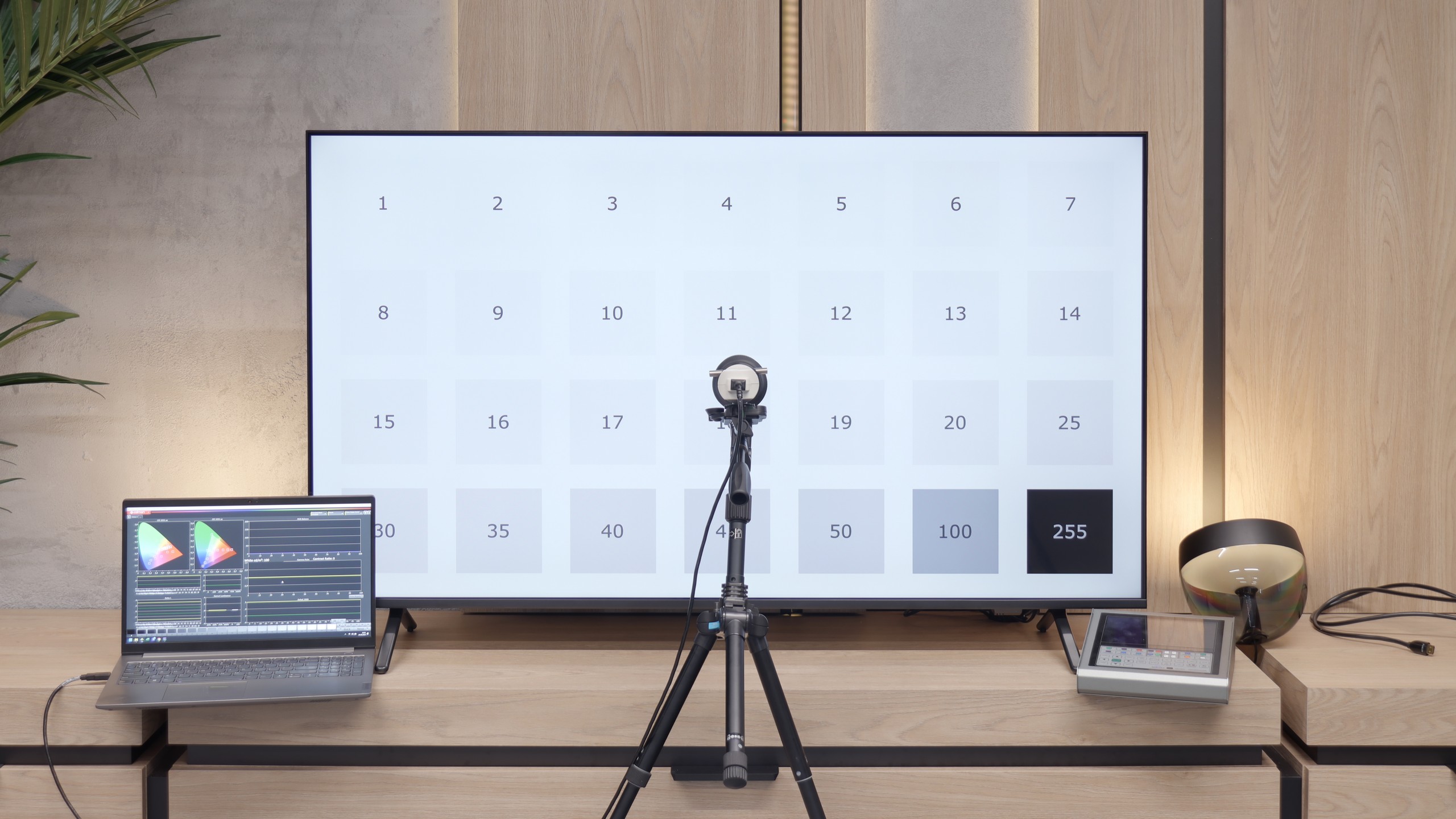
PHILIPS MLED920 - Our verdict
6.5
Overall rating
The Philips MLED920 is a natural continuation of last year's model PML9000, but it is not a repetition of the past. It is clear that the manufacturer has done their homework – primarily, the local dimming algorithms have been improved, which last year could significantly ruin the viewing experience. Now, blacks and contrast look much better, and with Dolby Vision present here, even HDR content appears quite decent. The picture can sometimes shine where it should, without straining the eyes during difficult scenes. Undoubtedly, the biggest asset of the MLED920 is its unique Ambilight system. The three-sided backlighting can give films and games a completely new atmosphere – the screen seems to extend beyond its borders, and the entire room becomes part of the viewing experience. This is something that not only cinema enthusiasts will appreciate but also gamers, who, alongside the lights, receive a full set of features typical for modern gaming TVs: 144 Hz, VRR, ALLM, and Dolby Vision Gaming. In this regard, Philips has a lot to offer. However. Indeed, there is a significant however – here we reach the most difficult part of this verdict – it is still a dual-purpose device. On one hand, we have a strong picture and a unique Ambilight feature, while on the other, there are hardware limitations that are hard to ignore. Titan OS in its current form is a considerable hindrance, full of bugs and deficiencies, which cause the television to lag behind the competition. On top of that, the price is not low at all given the offered capabilities. Therefore, it is difficult to recommend it unambiguously to everyone. However, if you are looking for the brightest Philips screen at a reasonable price, with Ambilight, a full set of gamer features, and basic applications – the MLED920 will be quite a suitable choice.
Advantages
Deep black and high contrast thanks to mini-LED backlighting
HDR brightness reaching 700–800 nits in real film scenes
Support for multiple HDR formats including Dolby Vision and HDR10+
Ambilight – an element that adds atmosphere, especially in the evening
A wide range of supported audio formats: DTS:X, Dolby Atmos, Dolby True HD 7.1
144 Hz panel with support for VRR, ALLM, and Dolby Vision Gaming
Loud sound (up to 88 dB)
Illuminated remote control
Disadvantages
Titan OS is quite underdeveloped – there are significant bugs and missing features in the applications
Few user functions
Hybrid infrared remote control
Issues with the fluidity of tonal transitions in dark scenes
The television is not suitable (other than for gaming) for use with a PC – strong dithering and poor readability of fonts, especially coloured ones and on dark backgrounds
Movies and series in UHD quality
6.4
Classic TV, YouTube
6.8
Sports broadcasts (TV and apps)
6.8
Gaming on console
8.5
TV as a computer monitor
4.0
Watching in bright light
5.5
Utility functions
5.5
Apps
6.7
Sound quality
6.2
Complete the survey to find out what fits your preferences
PHILIPS MLED920 - Competing TVs in this price range
PHILIPS MLED920 - TV appearance
HDMI inputs: 0 x HDMI 2.0, 4 x HDMI 2.1 (48Gbps) Outputs: Toslink (Optical audio), eARC (HDMI), ARC (HDMI), Mini-Jack (Headphones) Network Interfaces: Wi-Fi 2.4GHz, Wi-Fi 5GHz, Ethernet (LAN) 100Mbps
Build quality: Good
Stand type: Legs
Bezel color: Graphite









Stand: Fixed
Flat design: No
Accessories: Stand
The Philips MLED920 makes a good impression at first glance. Its slim bezels and metal legs add elegance, and when the screen is turned off, the 'borderless' effect appears, making the whole design look light and modern. However, just looking at it from the side or the back reveals another side of this model – the construction is solid but rather cumbersome, lacking the finesse of more expensive televisions. However, this is not a flaw that detracts from the enjoyment of use. After all, we spend most of our time looking at the screen from the front, and from that perspective, the MLED920 holds up quite well. Completing the whole package is the Ambilight system, a feature that has distinguished Philips for years. Here we have a three-sided version – the light spreads out along the sides and top of the wall, optically enlarging the screen and adding atmosphere during films, concerts, or matches. It is Ambilight that ensures that even when the television itself is turned off, it still remains something more than just a black rectangle in the living room. It gives it character and makes it difficult to confuse with any other model on the market.
Buy at the best price
Select size:
PHILIPS MLED920 - Contrast and black detail
7.9/10
Local dimming function: Yes, number of zones: 144 (12 x 12)

Result
298,900:1

Result
38,500:1

Result
23,950:1

Result
16,850:1

Result
8,000:1
Visibility of details in the lights:

The Philips MLED920 in the 55-inch version that we had the opportunity to test features a VA panel with high contrast. The panel itself is one thing, but the true distinguishing feature of this model is the mini-LED backlighting. This largely determines how black levels and contrast appear – and it must be said that Philips has made a significant leap forward compared to the models from 2024, where the local dimming algorithms were simply mediocre. The new version is much improved, and the contrast presented by the MLED920 can truly surprise positively. At times, it resembles the level known from the best LCD televisions on the market – blacks can be deep, the picture gains a sense of three-dimensionality, and watching films in a dark room makes a great impression. Of course, as with any mini-LED television, this is not a picture completely free of compromises. With a large amount of fine details on the screen, local dimming algorithms can sometimes get confused – at times dimming details more than we would like, and at other times brightening the background, resulting in slight, light blue halos around objects (the so-called halo effect). Despite these imperfections, we must emphasise that black levels and contrast are truly a strong point of the Philips MLED920 and definitely one of the reasons why it should be considered in the mid-range category.
Halo effect and black detail visibility:
PHILIPS MLED920 - HDR effect quality
5/10
Supported formats: HDR10, HDR10+, Dolby Vision, HLG Color gamut coverage: DCI P3: 89.9%, Bt.2020: 65.6%
Luminance measurements in HDR:

Result
722 nit

Result
177 nit

Result
775 nit

Result
131 nit

Result
677 nit
Philips MLED920 in our measurements in static tests even reached around 900 nits, which is really a solid result for a mid-range model. In practice, this translates to a lot of satisfaction during viewing sessions – in scenes rich in bright light, such as the first, third or fifth test slide, the screen managed to generate about 700 nits, which is sufficient to feel the true "HDR effect." However, it cannot be denied that the limited number of dimming zones and the compromises typical of mini-LEDs in more demanding scenes reveal their nature. In sequences with small light sources – like the moon or a scene from the film Sicario 2 – the television clearly prioritises maintaining deeper blacks at the expense of the brightness of these small elements. For most viewers, this is still a reasonable compromise, as the dark background looks significantly better, though it is important to be aware that the details themselves may not impress with their intensity. There is also a certain sense of dissatisfaction regarding the colours. Although the applied PFS filter (the equivalent of quantum dots known from QLEDs) does its job and the colours appear quite vivid, the coverage of the DCI-P3 palette reaches “only” 90%. In everyday viewing, this will be sufficient, but in extremely colourful productions – like the latest Disney animations – one can notice that some tones are not as vibrant as they could be in other setups.
Scene from the movie “Pan” (about 2800 nits)

Scene from the movie “Billy Lynn” (about 1100 nits)

Our viewing experience can be summarised as follows: the picture quality was quite decent, although there’s no denying – it is far from perfect. The colours were clearly exaggerated, which might be appealing at first glance, but in practice, it led to many special effects losing their charm. The sun in the film Mr and the fireworks in Billy Lynn appeared too flat, lacking the depth and naturalness we expected from a mini-led television. Looking at the dry measurements, we hoped that Philips would take a step forward in adapting the picture to various films and eliminate some of the issues evident in last year's models. Unfortunately, the end result turned out to be rather disappointing. The improvement is minimal, and the sense of dissatisfaction remains significant.
HDR luminance chart:
HDR luminance
Comparing HDR10 and Dolby Vision on the Philips MLED920, the difference is clear and hard to overlook. In films such as Pan and Billy Lynn, it was immediately noticeable that the television struggles with adapting images in the static HDR10 format. The dimming and tone mapping algorithms seem to get lost here, resulting in a flat effect that lacks that "energy" from high dynamic range productions. Luckily, the MLED920 supports Dolby Vision, which is a standard based on dynamic metadata that takes some of the workload off the television. This way, the device does not have to 'guess' how to render specific scenes – it receives ready-made instructions. As you can see, the final effect is quite strong. The same film segment in Dolby Vision looks completely different: colours are more saturated, contrast is deeper, and details in the highlights and shadows are definitely more visible. You could even say that Dolby Vision is a lifesaver for the MLED920 and enables the television to showcase its full capabilities.
Static HDR10

Dynamic: Dolby Vision

Factory color reproduction
5/10
Like every Philips television we tested, we primarily assessed the MLED920 in Filmmaker mode – this is meant to be the "most honest" mode, designed for films and to faithfully convey the intentions of the creators. Indeed, in terms of colour reproduction, it performs the best among all the modes available on the television, but it is not without flaws. The first thing that catches the eye is the white balance. The image has a slight tendency towards purple-pink tones, which gives it a somewhat unnatural character. An even bigger problem, however, turned out to be what we mentioned earlier – image blooming. Just looking at the gamma or EOTF charts reveals that the line significantly deviates from the norm, dropping below a value of 1.8. In practice, this means "bleeding" of the brightest whites, where the image becomes almost milky. Fortunately, most of these issues can be corrected – the MLED920 responds well to calibration, and with a few adjustments, one can significantly improve the viewing experience.
Color reproduction after calibration
7.5/10
After calibration, we managed to largely tame the white balance – to the extent that the average viewer will not be able to detect distortions in colours. The characteristic pink-purple haze that previously disrupted the naturalness of the image has also disappeared. The colour palette has been organised, and the colours appear more coherent and neutral. The gamma in SDR content post-calibration looks really good – there is no longer any mention of the previous 'bleeding' effect in bright scenes. The image has become more contrasty and devoid of that milkiness which had previously greatly harmed the viewing experience. In the case of HDR content, the improvement is also noticeable, although here it is still evident that the television is going 'its own way'. The EOTF curve cannot be fully shaped, as Philips simply does not offer the tools to allow precise control over this parameter in its settings. In many films, the television still exposes the image 'in its own way'. Despite these limitations, the calibration has delivered quite a bit of good – most of the colour distortions have been minimised, and the overall balance of the image has significantly improved. However, it must be noted that certain barriers stem from the very design of the hardware and simply cannot be overcome.


PHILIPS MLED920 - Smoothness of tonal transitions
6.5/10
The fluidity of tonal transitions in the Philips MLED920 is not its strongest point. In our tests, we quickly noticed that the television has noticeable issues in darker scenes – examples include segments from the film The Green Knight or test grey palettes. There, the characteristic banding of colours and too sharp transitions between shades can be quite evident, particularly in productions that maintain a darker aesthetic. Fortunately, the situation is better in brighter scenes – there, the image appears smooth and without significant artefacts.








Image scaling and smoothness of tonal transitions
7/10
Smooth transition function

Image without overscan on the SD signal

The manufacturer has equipped this model with several features that improve signal quality, and although we usually approach such "enhancements" with caution, here they prove to be really helpful. The key option is called "distortion reduction" – it works best at a medium level, as on one hand it effectively smooths out unwanted stair-stepping and colour banding, while on the other it does not excessively cut out details, allowing the image to still look natural.
Things are a bit worse with upscaling. Lower quality materials – such as the test video with the model – appeared soft and lacking in sharpness. Indeed, it can be partially corrected with the sharpness slider in the menu, but the effect remains far from what competitors in a similar price range offer. Philips therefore still needs to work on this element, as compared to the successful improvement of tonal transitions, the upscaling simply falls short.
PHILIPS MLED920 - Blur and motion smoothness
7.7/10
Maximum refresh rate of the panel: 144Hz
Film motion smoothing option: Yes
Blur reduction option: Yes
BFI function 60Hz: No
BFI function 120Hz: No

The Philips MLED920 features a 144 Hz panel, which immediately suggests that we shouldn't complain about motion smoothness. And indeed – the motion blur is relatively low for a VA panel, and although slight issues can sometimes be noticed on darker backgrounds, they are not something that would stand out to most people during regular viewing.
Another significant advantage is the presence of a motion smoother called “Motion Style.” It allows you to adjust the sensation of smoothness to your own preferences – if someone prefers a more “theatrical,” almost television-like image, they can increase the sliders, whereas if they prefer to maintain the natural “jumps” of cinematic frames, it’s enough to set lower values. This way, everyone can find their golden mean.
Blur (native resolution, maximum refresh rate):



Blur (4K@144Hz):



PHILIPS MLED920 - Console compatibility and gaming features
9.8/10
ALLM: Yes
VRR: Yes
VRR range: 48 - 144Hz
Dolby Vision Game Mode: Yes
Correct implementation of HGIG: Yes
1080p@120Hz: Yes
1440p@120Hz: Yes
4K@120Hz: Yes
Game bar: Yes


For gamers, the Philips MLED920 is truly a complete tool. The manufacturer has taken care of everything that is considered standard in televisions designed for consoles and PCs today. It features ALLM, so the console automatically switches the screen to game mode, alongside VRR and a refresh rate of 144 Hz, which guarantees smooth gameplay even in fast-paced titles. All key HDR formats are supported – including HGiG and Dolby Vision Gaming for Xbox – which means that regardless of what you are playing and on which console, the television will be able to extract the maximum potential from the image. The Game Bar also proves useful in daily gaming – a relatively simple implementation by Philips, but a functional panel where you can quickly check image parameters, enable VRR or adjust settings without leaving the game. It may not be as comprehensive as the competition, but it performs its task flawlessly. And finally, something that sets Philips apart from the competition – Ambilight. The three-sided LED backlighting can create a huge impression in games, especially in the evening. It's also a way to slightly 'extend' the screen and enhance the feeling of immersion. And as colourful LEDs have recently become almost a mandatory element of a gamer’s room, the MLED920 fits into this trend perfectly.



PHILIPS MLED920 - Input lag
9.6/10
The input lag on the Philips MLED920 is really very good – in 120 Hz mode, we measured values below 10 ms, which places this model among the absolute top tier of LCD televisions in terms of responsiveness. Even at 60 Hz, a result of around 18 ms is fully acceptable and will not interfere with any type of gameplay. A notable exception is the Dolby Vision mode at 60 frames, where the lag can increase to as much as 35 ms. This is a result that might be slightly jarring for esports players, but we must honestly admit – for most so-called "casual gamers", it will be absolutely imperceptible. Especially since we are talking about values that still allow for comfortable gaming without significant compromises.
| SDR | HDR | Dolby Vision |
|---|---|---|
| 1080p60: 18 ms | 2160p60: 17 ms | 2160p60 DV: 35 ms |
| 1080p120: 9 ms | 2160p120: 9 ms | 2160p120 DV: 9 ms |
| 2160p60: 17 ms | ||
| 2160p120: 9 ms |

PHILIPS MLED920 - Compatibility with PC
4/10
Chroma 444 (maximum resolution and refresh rate): Yes
Font clarity: Average
Readability of dark text and shapes: Poor
Input lag in PC mode (4K, maximum refresh rate): 9ms
Matrix subpixel arrangement: BGR
Max refresh rate: 144Hz
G-Sync: Yes
When it comes to working with a PC, the Philips MLED920 evokes quite mixed feelings. On one hand, it looks impressive on paper – we have 144 Hz, G-Sync, and FreeSync support, so in terms of gaming on a PC, the television does not disappoint. Anyone looking for a large screen for computer gaming gets a solid package of features here. However, when we try to use it as a typical monitor for everyday work, its limitations quickly become apparent. The fonts do not present themselves well – there is noticeable strong dithering, coloured letters can be jagged, and in the case of very dark text, there are even strange anomalies, as if the panel is losing thin lines and struggling to reproduce them correctly. In short: Yes for PC gaming. For any work and reading text: a definite no.
PHILIPS MLED920 - Viewing angles
3.2/10
Brightness drop at an angle of 45 degrees: 68%
The viewing angles in the MLED920 are classic for a VA panel – even a slight deviation from the centre causes the image to start losing colours, contrast diminishes, and the overall picture becomes quite flat and unappealing. There are no miracles here. So, if you're watching films with a larger group and everyone is sitting slightly off to the side, this will be somewhat noticeable. On the other hand, something for something: thanks to this panel, the MLED920 can display a much deeper black than televisions with IPS panels.
PHILIPS MLED920 - Daytime performance
5.5/10


Panel finish: Satin
Reflection suppression: Decent
Black levels during daytime: Good
The Philips MLED920 performs quite well in everyday use. The applied satin coating on the panel effectively reduces reflections, and in most moderately sunlit living rooms, it handles unwanted glare adequately. However, it should be noted that this is not a television that dazzles with brightness – the average value in SDR hovers around 450 nits. In very bright rooms, especially with large south-facing windows, the screen does not always manage to cut through the intense daylight. In such situations, it is worth supporting it with at least light curtains, so that viewing comfort is not significantly compromised.
Panel brightness
Average luminance SDR
Philips MLED920 / MLED910: 421 cd/m2
PHILIPS MLED920 - TV features
5.5/10
System: Titan OS
System performance: Decent
- HDMI inputs: 0 x HDMI 2.0, 4 x HDMI 2.1 48Gbps
- Outputs: Toslink (Optical audio), eARC (HDMI), ARC (HDMI), Mini-Jack (Headphones)
- Network Interfaces: Wi-Fi 2.4GHz, Wi-Fi 5GHz, Ethernet (LAN) 100Mbps
- TV reception: DVB-T, DVB-T2, DVB-S, DVB-S2, DVB-C
Classic features:
Recording to USB (terrestrial TV): No
Recording programming: No
Picture in Picture (PiP): No
RF remote control (no need to aim at the screen): Infrared
Backlit remote control: Yes
Teletext: Yes
Audio only mode: Yes
Bluetooth headphones support: Yes
Simultaneous Bluetooth headphones & TV audio: No
Smart features:
AirPlay: Yes
Screen mirroring (Windows Miracast): No
Voice search: Yes
Voice search in native language: No
Ability to connect a keyboard and mouse: Yes








Smart TV – Titan OS
Philips MLED920 uses the proprietary Titan OS, which is just starting its journey in the television market and unfortunately, this is evident at every turn. On one hand, we have basic functions – such as AirPlay support or the ability to mirror from a smartphone, but on the other hand, its limitations quickly become apparent. Screen mirroring only works with a phone, but not with a laptop. Voice search? Yes, but it is only supported by Amazon Alexa and only in the languages supported by this assistant. The system operates reasonably quickly, but from time to time it can "fail" and gives the impression of being something underdeveloped that is still evolving.
Classic TV Features
Titan OS also does not spoil users with classic television features. Apart from the hybrid remote control with a numeric keypad – which is indeed backlit and cleverly designed in two modes, it unfortunately works on infrared – there is nothing here that could truly distinguish the MLED920 from its competitors. There's a lack of USB recording or PiP functionality, and such features could be useful in this class. Among the unusual additions, however, there is an analogue output in the form of a jack that allows you to connect headphones or older speakers. It’s a small nod to users who still use older equipment.
Ambilight TV
What certainly draws attention away from the shortcomings of Titan OS is the unique, three-sided Ambilight system. Here Philips still plays in its own league and can impress those who have not encountered this addition before. The colourful backlighting that reacts to the content on the screen gives the viewing experience a unique atmosphere and is something that the competition does not offer in a similar form. It is the Ambilight that is supposed to make other issues – both system and functional – take a back seat.
Sound connection options
HDMI audio:
Other audio outputs:
Toslink: Yes
Stereo (Mini-Jack): Yes
Wireless audio:
Bluetooth: Yes
DTS Play-Fi: Yes
Supported audio formats (external HDMI eARC audio):
Dolby Digital Plus 7.1: Yes
Dolby True HD 7.1: Yes
Dolby Atmos in Dolby Digital Plus (JOC): Yes
Dolby Atmos in Dolby True HD: Yes
DTS:X in DTS-HD MA: Yes
DTS-HD Master Audio: Yes
Senior accessibility
Numeric keyboard on TV: Yes
Font size adjustment: Yes
Audio description: Yes
PHILIPS MLED920 - Apps
6.7/10























PHILIPS MLED920 - Playing files from USB
8.5/10

| Maximum photo resolution: | Supported photo formats: |
|---|---|
The built-in player in the Philips MLED920 works quite well and manages most popular audio and video files without major issues – exactly as you can see in our test table. Therefore, there are no concerns about typical movie or music formats. We can only criticise its rather selective support for photo formats and some resolutions.
PHILIPS MLED920 - Sound
6.2/10
88dB
Maximum volume
Supported codecs
(TV speakers)
Dolby Digital Plus 7.1
Dolby True HD 7.1
Dolby Atmos in Dolby Digital Plus (JOC)
Dolby Atmos in Dolby True HD
DTS:X in DTS-HD MA
DTS-HD Master Audio
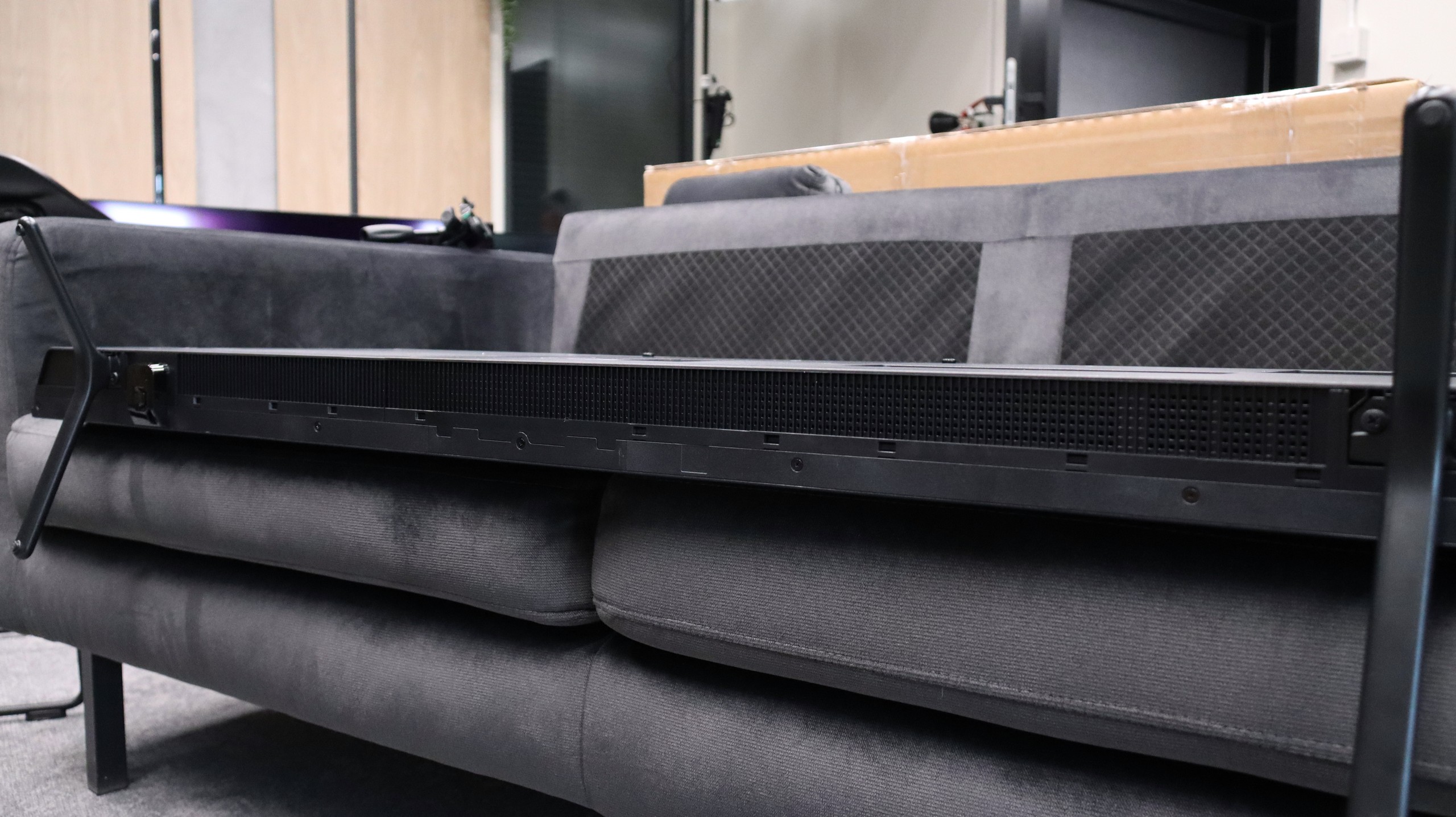
The sound on the Philips MLED920 is unlikely to be the element that impresses you the most. It sounds rather flat, lacking depth and clearer bass, which means that films or concerts do not have that additional layer of immersion that a better audio system can provide. However, it must be acknowledged that the volume is at a really respectable level – the television can reach up to 88 decibels. A significant advantage of the MLED920 is not so much the sound quality itself, but the handling of audio formats. Philips has ensured compatibility with practically all the major standards, including Dolby Atmos, DTS, and Dolby TrueHD 7.1. As a result, if someone decides to connect an external soundbar or amplifier, they will encounter no limitations and will be able to enjoy the full cinema sound experience.
Sound Quality Test:
Acoustic Measurements
88dBC (Max)
75dBC
PHILIPS MLED920 - Panel details
Software version during testing: TPN258E_V058.002.179.041
Subpixel Structure:

Panel uniformity and thermal imaging:
Backlight Type: Mini-LED PFS LED

Founder and originator of the "ChooseTV" portal

Journalist, reviewer, and columnist for the "ChooseTV" portal
See articles related to Philips MLED920 / MLED910:
4/3/2025
10/2/2025
7/17/2025
9/8/2025
Shopping Reviews
The best Philips TVs of 2024 – these models are worth buying... 5/22/2025





